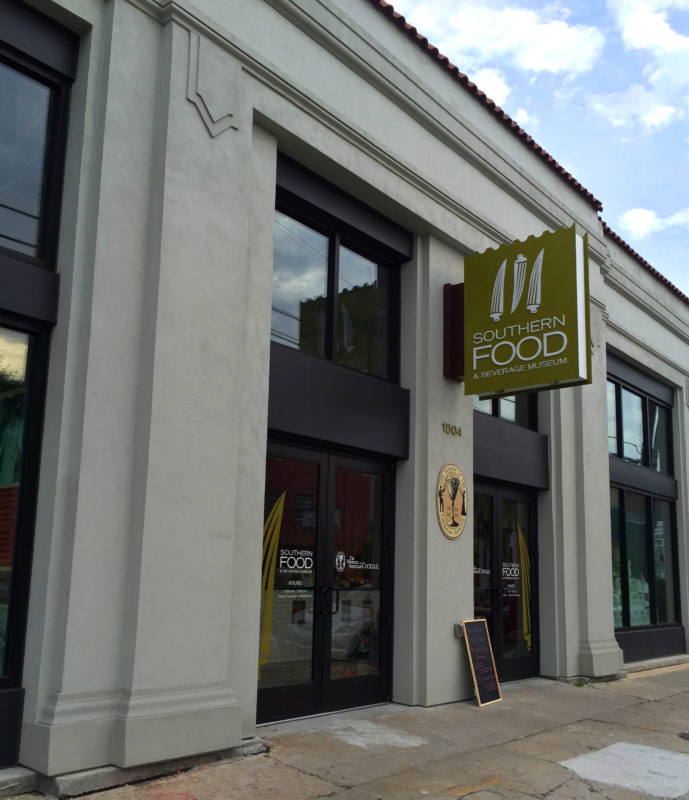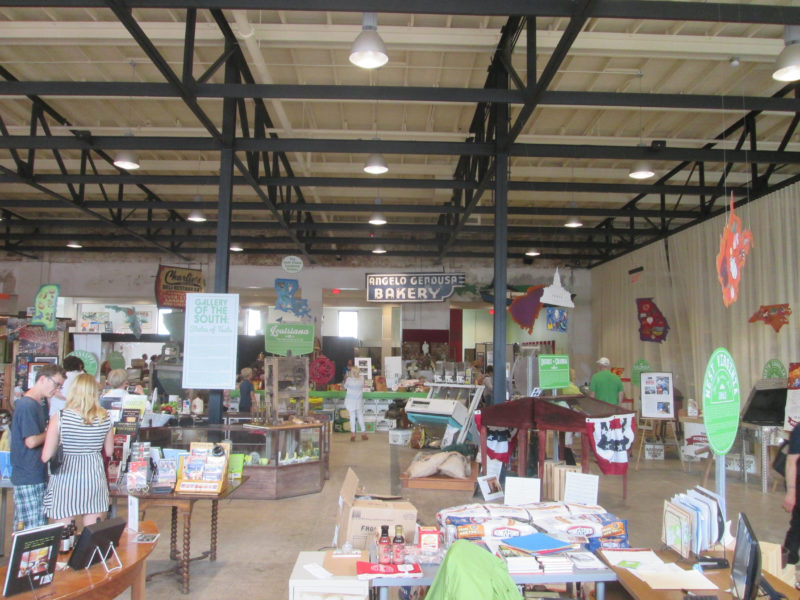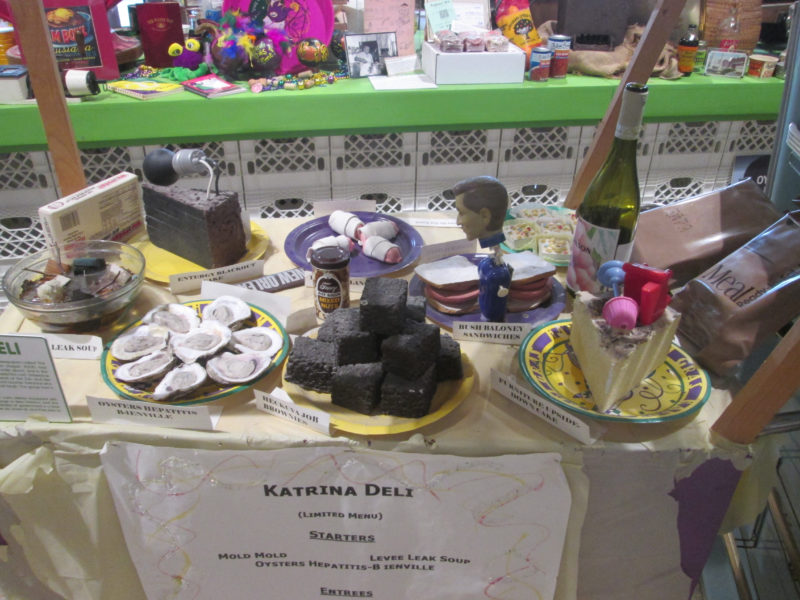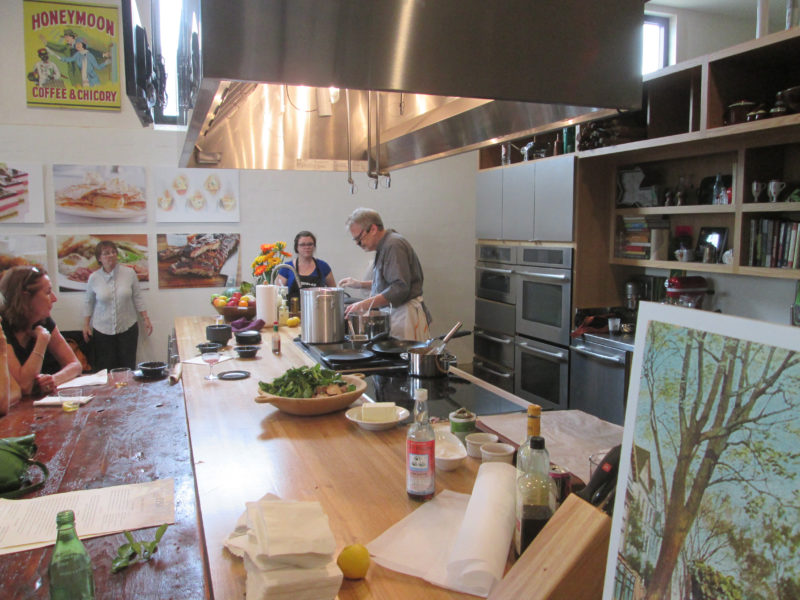The Southern Food and Beverage Museum, which is abbreviated SoFAB, opened on June 7, 2008 in the Riverwalk Marketplace. Liz Williams, who was previously involved with the creation of the World War II Museum and the Ogden Museum of Southern Art, founded SoFAB and currently serves as its president (McDowell, Adam 27 Aug 2008. “Spirits of the South; What it means to eat and drink in New Orleans three years after Katrina.” National Post. New Orleans, LA. http://www.lexisnexis.com/us/lnacademic/(accessed October 11, 2009)). The museum focuses on the food and drink of the Southern states and the numerous ethnic groups that have influenced it. The museum uses a diverse array of artifacts and media, including photographs, cookware, cookbooks, and audio recordings to highlight the histories of Southern foods. SoFAB also organizes educational programs and hosts a variety of local events.
Purpose

The current storefront of SoFAB. Photo provided by Yelp Inc, reproduced here under the Creative Commons.
The museum features the histories of various types of Southern cuisine across the Southern states all the way from Texas and Oklahoma to Maryland, and also from the District of Columbia. SoFAB culinary histories include food influenced by different cultures, such as Creole, Cajun and Italian populations in Louisiana, and the Mexican population in Texas. The museum shows histories of foods and beverages made by people of all different classes, from the poor to the wealthy and famous. The museum places an emphasis on the people who are responsible for the various processes involved in the creation of different types of Southern cuisine, such as chefs, inventors, farmers and fisherman. Liz Williams said that the museum “makes [its founders] feel like [they] are part of the cultural rebuilding of the city,” and that the museum “will be a constant promotion of the products of New Orleans, the products of the state, the culture of the city and the state” (Walker, Judy, and MacCash, Doug 8 Oct 2006. “A pantry of its own; Food museum finds a home upstairs at the CAC.” Times-Picayune. New Orleans, LA. http://global.factiva.com (accessed October 12, 2009)). The museum opened in a time when several other groups in New Orleans were creating institutions that focus on the cultural importance of Southern cuisine. These institutions include Dillard University’s Institute for the Study of Culinary Culture as well as its African Food Ways Institute, and SoFAB’s sister museum, the Museum of the American Cocktail (Elie, Lolis Eric 2 Jun 2008. “Food holds court in museum.” Times Picayune. New Orleans, LA. http://global.factiva.com (accessed October 12, 2009) ; Jervis, Rick 13 Jun 2008. “Now on the Menu in New Orleans: A museum for Southern cuisine” USA Today. New Orleans, LA. http://global.factiva.com (accessed October 12, 2009)).
History
SoFAB creator Liz Williams began planning the museum in 2002. She teamed up with Matt Konigsmark, who moved to New Orleans from San Francisco around this time. In California he had seen the opening of another food related museum called Copia in Napa, which focuses on California food and wine (Walker). The founders of SoFAB made plans to move to a permanent location that was destroyed by Hurricane Katrina. (Chandler, Jennifer 12 Sep 2007. “SoFAB wants your Southern menus.” The Commercial Appeal. http://global.factiva.com (accessed October 12, 2009)). The museum’s entire collection was destroyed in the storm by flooding. SoFAB lost more than 3,000 cookbooks (McDowell). SoFAB announced a move to a permanent location in late 2006, but these plans never materialized. The museum was to be located on the third floor of the Contemporary Arts Center (CAC) building at 900 Camp St. This floor had seldom been used since the warehouse building was donated to the arts organization in 1999. CAC Director Jay Weigel expressed hopes that the additional visitors in the building would bring more traffic into the arts center (Walker). The museum later moved to a different location, in the Riverwalk Marketplace. In 2009, Zagat, a prominent dining and tourism guide, added SoFAB to its exclusive list of recommended attractions in New Orleans, which the company creates based on the input of local consumers (7 Jan 2009. Zagat Launches 2009 New Orleans Guide. Wall Street Journal. http://southernfood.org/content/index.php?id=562 (accessed October 12, 2009)).
Early Exhibits

The main exhibit floor. Photo by Infrogmation of New Orleans, reproduced here under the Creative Commons.
“A Toast to New Orleans”
The museum first opened in June, 2004 at a location on 1400 Poydras St. as a temporary exhibit. The exhibit was called “A Toast of New Orleans,” and it focused on beverages that are significant to New Orleans (Sweets, Ellen 9 Jun 2004. “Me oh, my oh: New Orleans hosts Southern food museum.” Denver Post. http://global.factiva.com (accessed October 12, 2009)). The main focus was the Sazerac cocktail, but the exhibit also highlighted regional drinks such as Barq’s root beer, and coffee with chicory. This exhibit functioned as a preview that helped the museum to raise funds for the permanent museum (Hoekstra, Dave 30 Aug 2006. “Comfort Food: Food museum helps hurricane survivors to savor New Orleans traditions.” Chicago Sun-Times. New Orleans, LA. http://global.factiva.com (accessed October 12, 2009)).
“Restaurant/Restorative”
In 2006, SoFAB’s senior curator Elizabeth Pierce, who had previously served as curator for the “Toast to New Orleans” exhibit, created a SoFAB exhibit called “Restaurant/Restorative,” which examined the restaurant culture in New Orleans during the aftermath of Hurricane Katrina. This exhibit debuted at the 2006 James Beard Foundation Restaurant Awards in New York and traveled to several other locations including Kendall College in Chicago and Google’s New York headquarters (20 Jul 2007. “Museum news.” Times Picayune. New Orleans, LA. http://global.factiva.com (accessed October 12, 2009)).
Riverwalk Marketplace
The museum opened in a permanent location on June 7th, 2008 at the Julia Street entrance of the Riverwalk Marketplace on the third floor (21 Feb 2008. “Food Briefs.” Times Picayune. New Orleans, LA. http://global.factiva.com (accessed October 12, 2009)). The marketplace occupies a space that was originally built for the 1984 World’s Fair. In 1986 the space reopened as the Riverwalk Marketplace, a large shooping mall (Riverwalk Marketplace. http://www.neworleansonline.com/neworleans/shopping/riverwalk.html (accessed November 22, 2009)). This location is right next to the Mississippi River as well as the Central Business District and the French Quarter. These areas have a high amount of tourism that may help bring visitors into the museum. Many tourists go to the Riverwalk area to see the Mississippi River and visit the Audubon Aquarium, which is a short walk from the mall. Harrah’s casino is another major nearby attraction, and it may help bring visitors into the museum. The Museum of the American Cocktail shares the same 15,000-square-foot space with the Southern Food and Beverage Museum. It contains a dense collection of media and artifacts that focus on the history of cocktails in the United States (Jervis).
Exhibits
The museum has several permanent exhibits that focus on a variety of topics such as the history of Louisiana cuisine, tableware representing the Southern states, cuisines of different Southern states, and alcoholic beverages in the South.
Louisiana Eats! Laissez Faire-Savoir Faire
The exhibit nearest the entrance to the museum is called “Louisiana Eats! Laissez Faire-Savoir Faire. This exhibit informs visitors about the history of Louisiana food and beverages and the people who were involved in creating and perfecting them. This exhibit contains many different artifacts such as cookware and models of dishes, and a large amount of media such as photographs and text that describe the histories of foods and beverages in Louisiana. There are several booths along the wall in this exhibit that detail the histories of different traditional foods, beverages and restaurants in the state. The exhibit includes booths for gumbo, crawfish, shrimp, oysters, po-boys, the Dooky Chase restaurant, and pralines. The booths contain photographs of foods and people who cook them, and artifacts, such as pots and a coffee grinder. They also feature text that describes the histories of the foods, beverages and places, and includes quotes of famous people about the topics of the booths. The text often references cookbooks and famous peoples’ recipes in relation to the making of the dishes. There are numerous artifacts in the middle of the room that houses this exhibit, such as brulôt cups, a crab pot used for trapping crabs, and models of 1960s style oyster and shrimp luggers, which are boats used for catching these animals. Some other booths cover topics like Louisiana produce, and the marketing of food in Louisiana. The histories of different dishes mostly discuss how the foods became popular in Louisiana, and the the defining elements of the dishes. This exhibit also features a Katrina themed deli cart that was pushed during Mardi Gras by locals. The cart’s menu lists humorous spins on restaurant dishes, such as “Oysters Hepatitis Bienville” and “Entergy Blackout Cake” (Walker). Next to the deli cart there is a table that is one of many that were built for returning families after Katrina to replace the ones that Hurricane Katrina destroyed. There are ready to eat meals and other similar items on this table that show visitors what kind of food many people had to eat after the storm hit the city. There are also some items such as plates on the table that were recovered after the storm, one from Dooky Chase.

The “Katrina Deli” spread. Photo provided by Infrogmation of New Orleans.
Southern Table
An exhibit called “Southern Table” displays tableware representing the Southern States. As many of these dishes are the official tableware of the different states’ Governor’s mansions, and others are similarly representative of their states, this exhibit represents the eating experience of the cultural elite in different Southern states. Every state that is shown in the exhibit has at least a plate to represent it, and some have additional dishes such as coffee cups, wine glasses and bowls. Detailed maps accompany the dishes for each state.
Eating Around the South
The exhibit “Eating around the South” focuses on the cuisines of different states. It currently includes sections for Arkansas, Maryland and Texas. This exhibit primarily focuses on foods and beverages that are significant to different states, such as margaritas and tex-mex in Texas, spring water and spinach in Arkansas, and Smith Island cakes in Maryland. There is a display about Elvis in another area of the museum that will be part of the Tennessee section of the Eating Around the South Exhibit. This display shows visitors how Elvis was improtant to culinary culture. The display shows one of Elvis’ favorite dishes, the fried peanut butter and banana sandwich, and it discusses Elvis’s eating preferences, such as the fact that he preferred home cooked meals and fast food to gourmet food. This exhibit helps expand the range of the museum outside of the Louisiana culinary tradition and shows visitors detailed culinary histories that are unique to different Southern states.
Southern Likker
The exhibit “Southern Likker” focuses on the role of alcoholic beverages in Southern life, and it prominently features a bar that was recovered from the Brunnings Restaurant after Hurricane Katrina. This bar is the third oldest existing bar in the city, and it dates back to the 1840s. There is also a collection of miniature liquor bottles in this exhibit that represent many of the different types of liquor that are made in the South. This collection was donated by Tropical Isle, a New Orleans bar located on Bourbon Street.
Eating in the White House
This exhibit focuses on the history of food in the white house. It contains several artifacts, including dishes used in the White House during diffferent presidential administrations that go back as far as Ulysees S. Grant. The exhibit also contains White House cookbooks and discusses the history of their publication. The exhibit contains numerous photographs, both of food preparation and dining in the White House. This exhibit helps visitors understand how food in the White House fits in the Southern culinary tradition, and it shows visitors what food prepration and dining are like in the White House.
Media Room
The museum contains a media room which features booths containing computers linked to an online resource which allows visitors to access interviews of people who make traditional Southern food. Many of these people are chefs from well known restaurants who discuss certain dishes that they cook in their restaurants. The interviews are obtained from the website of the organization Southern Foodways Alliance. Several particular foods are highlighted. These include barbeque, gumbo and tomales. The web pages contain transcripts of the interviews, and audio clips of people telling personal stories about dishes they prepare. There are slide shows accompanied by audio clips in which people tell more detailed histories about the restaurants they work in or the dishes they cook. The slide shows contain images of the restaurants, the interviewees, and the restaurants’ dishes. These interviews show viewers the people who cook popular Southern dishes and how they make them. The interviews allow visitors to get a more first-hand account of the preparation of Southern dishes from the people who make them.
Collections
The Museum holds several collections, which include cookbooks, menus and artifacts relating to Southern food. The museum has a culinary library that is the result of a partnership with the New Orleans Public Library, which is the culinary library’s home. The library contains a collection of books, manuscripts, booklets, and documents related to Southern food and drink. This collection is located in the New Orleans Public Library (SoFAB Collections. http://southernfood.org/content/index.php?id=425 (accessed November 22, 2009)). The museum holds a collection of Southern restaurant menus called The Menu Project. This project has the goal of collecting menus of all restaurants in the South and all of the restaurants in the world that are inspired by the South (The Menu Project. http://southernfood.org/content/index.php?id=323 (accessed November 22, 2009)). SoFAB collects these menus systematically, year by year so that the collection is complete and can show changes in prices, trends and menu design over the years. The Menu Project collection is kept in the Earl K. Long Library at the University of New Orleans. The collection already holds several thousand menus (Hoekstra). The museum also has a collection of artifacts and archives such as photographs, business records, and films (THe SoFAB Archive. http://southernfood.org/content/index.php?id=428 (accessed November 22, 2009)).
Events

A cooking demonstration in progress. Photo provided by Infrogmation of New Orleans.
SoFAB hosts numerous culinary themed events at both the museum and other New Orleans locations. SoFAB co-hosted a 2007 event with the restaurant Savvy Gourmet. The event was similar in style to the Antiques Roadshow, and attendees were encouraged to bring in items related to cooking, eating, or drinking. The event served as a fundraiser for SoFAB; in exchange for $25 donations, participants were given informal insurance valuations by local appraisers from the insurance firm Matthew Clayton Brown. SoFAB sometimes hosts cooking demonstrations in the Edward A. Johnston and Carol T. Pearce Tasting Room of the museum (19 Jul 2009. “Culinary antiques event set in N.O.“The Baton Rouge Advocate. New Orleans, LA. http://global.factiva.com (accessed October 12, 2009)).
Education
SoFAB is involved in multiple educational programs.
Culinary Club
The museum started a culinary club in September 2009 for New Orleans high school students. At monthly meetings, students and leaders discuss food-related issues such as the life of a restaurant chef, food and ethics, and writing about food. Students who participate in the club volunteer at the SoFAB library by cataloging books (Lee, 3 Sep 2009. “Museum presents teen culinary club.” Times-Picayune. New Orleans, LA. http://global.factiva.com (accessed October 12, 2009)).
The Big Read
SoFAB partners with the New Orleans Public Library to organize an annual educational program called “The Big Read.” This program is part of a national initiative of the National Endowment for the Arts “to encourage reading for pleasure and enlightenment,” and it has expanded from 10 communities in its first year to 400 communities in 2009. The program consists of approximately one month of events that focus on a selected novel. The events include kick-off and closing parties, panel discussions, teacher workshops, film screenings and other events. The local sponsors create lesson plans to guide teachers and students through learning about the book. In 2008, SoFAB and NOPL chose the book To Kill a Mockingbird, by Harper Lee, and for 2009, they chose Their Eyes were Watching God by Zora Neale Hurston. Lessons highlighted the various dishes that were referenced in these novels (Big Read NOLA 2009. http://bigreadnola.wordpress.com/about/ (accessed November 5, 2009)).
Partnerships
The museum has several partnerships with other institutions that are mutually beneficial to the museum and the partners. The museum has a partnership with Southern University of New Orleans that is beneficial to the university’s participating students. According to SoFAB’s website “SUNO houses, catalogs and prepares condition reports of all of the artifacts that have been collected by SoFAB.” As participants in this partnership, SUNO museology students gain “hands-on experience working with artifacts” (Partnerships. http://southernfood.org/content/index.php?id=73 (accessed November 5, 2009)).
Publications
Room in the Bowl
Editors Jamie Tiampo and David Galent have put together a book called Room in the bowl: the IACP Gumbo Giveback Project that is dedicated to the Louisiana dish from which it gets its name. This book is a collection of photographs and stories about gumbo’s ingredients and peoples’ experiences with the dish. Proceeds from the book are equally divided between SoFAB and the International Association of Culinary Professionals (IACP). The book is exclusively sold in the museum’s gift shop. The book is a result of a collaboration between members of photographer, food writer, and food stylist sections of the IACP who met in New Orleans in April 2008 and decided to make a tribute to the dish and a record of their visit to New Orleans (22 Apr 2009. “Room in the Bowl book gives back to culinary community.” http://southernfood.org/content/index.php?id=606 (accessed November 6, 2009)).








